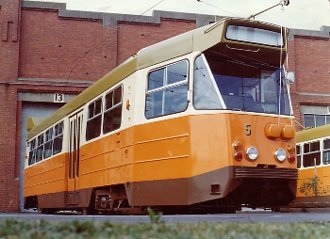Melbourne Tram Museum
- Follow Melbourne Tram Museum on Twitter
- Follow Melbourne Tram Museum on Facebook
- Follow Melbourne Tram Museum on Instagram
- Follow Melbourne Tram Museum on Pinterest
- Follow Melbourne Tram Museum on Tumblr
- Subscribe to Melbourne Tram Museum's RSS feed
- Email Melbourne Tram Museum
Fares please! An economic history of the Melbourne & Metropolitan Tramways Board
Legacy of the M&MTB
With the election of the Cain government in 1982 came the end of the M&MTB. It was legislated out of existence on 1 July 1983, becoming part of the Metropolitan Transit Authority (MTA), which also included the suburban railways and Government (M&MTB and VR) bus operations.
The M&MTB was an unusual organisation in that it existed for 64 years with only five men acting as Chairman, which in the case of the Board was more like the role of Chief Executive Officer. This gave the M&MTB a strong sense of continuity, which was reflected in the respect in which it was held by the general public.
The first three chairmen had vastly more experience than their political masters and were public figures in their own right. This gave them a measure of independence and control that was denied to the final two chairmen, Kirby and Snell. There is no doubt that during the 1950s and 1960s that almost every adult Melburnian knew that Major-General Risson was head of the tramways – but very few of them could have told you the name of the Minister for Transport.
Once the State Government began supporting the M&MTB with large operational subsidies, effective control of the tramways passed from Kirby and Snell to the State Government – under the principle of ‘he who pays the piper calls the tune’. As a result, the position of Chairman became almost invisible to the public, and the Minister for Transport became the public face of the Melbourne tramway system.
No annual report was ever issued for 1982-83 so the details of the final year of operations are not publicly available.
 M&MTB Z 5 at Preston Workshops, April 1975.
M&MTB Z 5 at Preston Workshops, April 1975. - Photograph courtesy Greg King.
The creation of the MTA brought forth a new form of management reporting. Commencing in 1983-84, annual reports lacked the detail of the old M&MTB reports, focusing more on glossy pictures, glib self-congratulatory text and embossed statements of accounts rather than providing transparency into the activities and financial status of the organisation. It is effectively impossible to gather the details of the financial status of the Tram & Bus Division of the MTA from published sources, so that comparisons are not possible between the MTA and the M&MTB.
This change was the final stage in the evolution of the Melbourne tramway system from a viable business to a loss-making social service funded primarily from general taxation, as the policy was to disguise the true cost of running Melbourne’s tramway system.
However, the M&MTB served Melbourne well during its 64 years of existence. It shaped our suburbs, carried commuters to and from work and students to and from school. It is remembered with respect by older Melburnians, and not without some regret for its disappearance – and it ensured the retention of the tramway system during the challenges of the 1950s and 1960s, so that now the tram is a much-loved icon of Melbourne.
The tram is the only truly socially acceptable form of public transport in Melbourne – people of all classes will use a tram. For example, a CEO of a major corporation will think nothing of leaping onto a Collins Street tram to get from one end of the city to the other, but you would never see him on a train or a bus. Trams are one of the socially cohesive facets of our city that binds us together and makes Melbourne such a pleasant place to live.
From a retrospective viewpoint, over the last 120 years the Melbourne tramway network has moved from being run by a private monopolistic company, to a number of semi-government authorities and private companies, to a monopolistic government authority, to a privatised duopoly and finally a private monopoly. The wheel has turned a complete circle – but the decisions made by the M&MTB during its 64 years of existence still shape the nature of our tram system and our city.
And for that we have to thank the stalwart men and women of the Melbourne and Metropolitan Tramways Board.